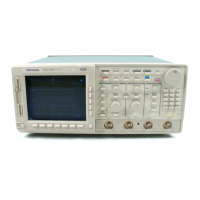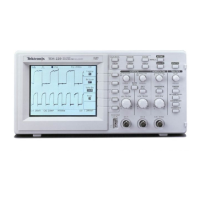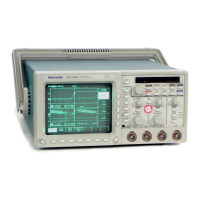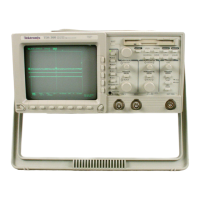Nominal Traits
2–12
TDS 500D, TDS 600C, TDS 700D & TDS 714L Performance Verification and Specifications
Table 2–4: Nominal traits — Time base system
Name Description
Range, Sample-Rate
1,3
TDS 684C: 5 Samples/sec to 5 GSamples/sec on four channels simultaneously
TDS 680C: 5 Samples/sec to 5 GSamples/sec on two channels simultaneously
TDS 654C: 5 Samples/sec to 5 GSamples/sec on four channels simultaneously
TDS 694C: 5 Samples/sec to 10 GSamples/sec on four channels simultaneously
TDS 520D, and 724D: 5 Samples/sec to 2 GSamples/sec when acquiring 1 channel,
to 1 GSample/sec when acquiring 2 channels
TDS 540D: 5 Samples/sec to 2 GSamples/sec when acquiring 1 or 2 channels,
to 1 GSample/sec when acquiring 3 or 4 channels
TDS 540D Opt. 1G: 5 Samples/sec to 1 GSample/sec when acquiring 1 to 4 channels
TDS 714L: 5 Samples/sec to 500 MSamples/sec when acquiring 1 to 4 channels
TDS 754D: 5 Samples/sec to 2 GSamples/sec when acquiring 1 or 2 channels,
to 1 GSample/sec when acquiring 3 or 4 channels
TDS 754D Opt 1G: 5 Samples/sec to 1 GSample/sec when acquiring 1 to 4 channels
TDS 580D, 784D, and 794D: 5 Samples/sec to 4 GSamples/sec when acquiring
1 channel, to 2 GSamples/sec when acquiring 2 channels,
or to 1 GSample/sec when acquiring 3 or 4 channels
Range, Interpolated Waveform Rate
2,3
TDS 600C: 10 GSamples/sec to 250 GSamples/sec
TDS 694C: 10 GSamples/sec to 500 GSamples/sec
TDS 520D, 540D, 714L, 724D, and 754D: 1 GSample/sec to 100 GSamples/sec
TDS 580D, 784D, and 794D: 2 GSamples/sec to 250 GSamples/sec
Range, Seconds/Division TDS 600C: 0.2 ns/div to 10 s/div
TDS 694C: 0.1 ns/div to 10 s/div
TDS 500D, 714L, 724D, and 754D: 0.5 ns/div to 10 s/div
TDS 580D, 784D, and 794D: 0.2 ns/div to 10 s/div
Artisan Technology Group - Quality Instrumentation ... Guaranteed | (888) 88-SOURCE | www.artisantg.com

